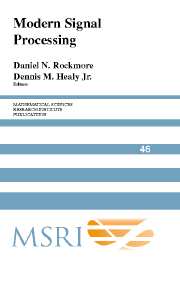Book contents
- Frontmatter
- Contents
- Introduction: A New Generation of Signal Processing
- Hyperbolic Geometry, Nehari's Theorem, Electric Circuits, and Analog Signal Processing
- Engineering Applications of the Motion-Group Fourier Transform
- Fast X-Ray and Beamlet Transforms for Three-Dimensional Data
- Fourier Analysis and Phylogenetic Trees
- Diffuse Tomography as a Source of Challenging Nonlinear Inverse Problems for a General Class of Networks
- An Invitation to Matrix-Valued Spherical Functions: Linearization of Products in the Case of Complex Projective Space P2(ℂ)
- Image Registration for MRI
- Image Compression: The Mathematics of JPEG 2000
- Integrated Sensing and Processing for Statistical Pattern Recognition
- Sampling of Functions and Sections for Compact Groups
- The Cooley-Tukey FFT and Group Theory
- Signal Processing in Optical Fibers
- The Generalized Spike Process, Sparsity, and Statistical Independence
Signal Processing in Optical Fibers
Published online by Cambridge University Press: 25 June 2025
- Frontmatter
- Contents
- Introduction: A New Generation of Signal Processing
- Hyperbolic Geometry, Nehari's Theorem, Electric Circuits, and Analog Signal Processing
- Engineering Applications of the Motion-Group Fourier Transform
- Fast X-Ray and Beamlet Transforms for Three-Dimensional Data
- Fourier Analysis and Phylogenetic Trees
- Diffuse Tomography as a Source of Challenging Nonlinear Inverse Problems for a General Class of Networks
- An Invitation to Matrix-Valued Spherical Functions: Linearization of Products in the Case of Complex Projective Space P2(ℂ)
- Image Registration for MRI
- Image Compression: The Mathematics of JPEG 2000
- Integrated Sensing and Processing for Statistical Pattern Recognition
- Sampling of Functions and Sections for Compact Groups
- The Cooley-Tukey FFT and Group Theory
- Signal Processing in Optical Fibers
- The Generalized Spike Process, Sparsity, and Statistical Independence
Summary
This paper addresses some of the fundamental problems which have to be solved in order for optical networks to utilize the full bandwidth of optical fibers. It discusses some of the premises for signal processing in optical fibers. It gives a short historical comparison between the development of transmission techniques for radio and microwaves to that of optical fibers. There is also a discussion of bandwidth with a particular emphasis on what physical interactions limit the speed in optical fibers. Finally, there is a section on line codes and some recent developments in optical encoding of wavelets.
1. Introduction
When Claude Shannon developed the mathematical theory of communication [1] he knew nothing about lasers and optical fibers. What he was mostly concerned with were communication channels using radio- and microwaves. Inherently, these channels have a narrower bandwidth than do optical fibers because of the lower carrier frequency (longer wavelength). More serious than this theoretical limitation are the practical bandwidth limitations imposed by weather and other environmental hazards. In contrast, optical fibers are a marvellously stable and predictable medium for transporting information and the influence of noise from the fiber itself can to a large degree be neglected. So, until recently there was no real need for any advanced signal processing in optical fiber communications systems. This has all changed over the last few years with the development of the internet.
Optical fiber communication became an economic reality in the early 1970s when absorption of less than 20 dB /km was achieved in optical fibers and lifetimes of more than 1 million hours for semiconductor lasers were accomplished.
Information
- Type
- Chapter
- Information
- Modern Signal Processing , pp. 301 - 316Publisher: Cambridge University PressPrint publication year: 2004
